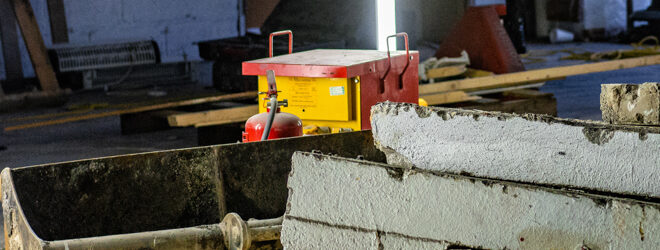As a home builder or contractor, you face a number of fire risks — both accidental and intentional. Whether you’re building a new home, or renovating an existing one, you don’t want your work to go up in smoke.
Fires on construction sites can be caused accidentally (for example, by hot work) or intentionally. While a builder’s risk insurance policy can help recover losses in the event of a fire, it’s much easier to avoid an incident in the first place by keeping a clean site and taking safety precautions.
How accidental fires can occur
Here are some of the most common accidental building fire risks, and what you can do about them:
- Temporary heaters:
During colder months, temporary space heaters are often used on jobsites. But if an unvented, self-contained heater is improperly installed — without proper clearance — it could ignite a fire.
Risk mitigation: Follow all recommended safety tips when using temporary heaters. Aside from providing proper clearance away from flammable materials, make sure the type of heater you’re using is covered under your insurance policy.
- Hot work:
Welding, soldering, and cutting are potential ignition sources if safety precautions aren’t taken, especially in areas with flammable materials. Fires often occur when a ‘quick’ job is done in an area not intended for hot work.
Risk mitigation: A hot work management program should include policies on when and where hot work is permitted, and procedures on assessing and preparing an area for hot work. The Canadian Centre for Occupational Health and Safety has a comprehensive list of safety procedures, which includes posting a trained fire watcher in the area to look for sparks or slag for up to three hours or more after the end of hot work.
- Smoking: Flicking a cigarette butt onto the ground could see your jobsite go up in flames. In 2021, Statistics Canada reported that 2,612 structural fires were caused by “smoker’s material and open flame,” which includes cigarettes, matches, and ashtrays.
Risk mitigation: Workers should only smoke in designated areas and cigarette butts should be disposed of properly. Your fire safety manager will need to rigorously enforce these rules.
How intentional fires can occur
As noted by Statistics Canada,1,686 structural fires in 2021 were caused by an incendiary act, which refers to “deliberate acts of arson caused by individuals or groups of persons during riots, civil disturbances, acts of vandalism or mischief”.
While home builders and contractors may not be able to prevent all cases of theft, vandalism, and arson, they can take steps to avoid being a target. For example, using security measures such as fencing, lighting, motion sensors, security cameras, access control systems, and other perimeter controls can help. In some cases, it may also make sense to hire after-hours security guards.
Steps to help mitigate fires during construction:
- Keep up with daily housekeeping, which should include cleaning up the jobsite at least daily, making sure no combustible materials are left lying around, and regularly removing combustible materials off the jobsite.
- Make sure there are readily accessible fire extinguishers on site and that everyone is trained on how (and when) to use them. For example, in the case of an electrical fire, a water fire extinguisher should not be used.
- Establish procedures in the event of a fire. Who will call the fire department? Who will evacuate the site? Make sure all employees are trained on what to do in the event of a fire.
- Establish Site Protocols that address the above noted risk exposures
- Temporary Heating
- Hot Works
- Site Smoking
Builder’s risk insurance
A builder’s risk policy can help to cover losses on a jobsite over the course of construction, including losses from fire, theft, and vandalism. It may also cover the cost of physical damage to building materials, scaffolding, and temporary buildings, as well as soft costs such as legal fees.
Coverage will depend on the builder’s construction schedule and budget but can be increased if the scope of the project increases. While it’s not a legal requirement, in some cases builders and contractors may be required to provide proof of insurance by a client or for government-funded projects.
Protect yourself and your business with insurance
Despite your best efforts and preparation, there are some things that you simply can’t control. Want to make sure your construction site is properly protected? Learn more by visiting our construction and contractors’ insurance page today!




